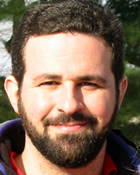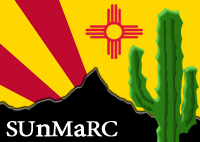| Invited Speakers
 Patrick Weidman, Department of Mechanical Engineering, University of Colorado at Boulder Patrick Weidman, Department of Mechanical Engineering, University of Colorado at Boulder
Patrick Weidman is Professor Emeritus of
Mechanical Engineering and Affiliate Professor of Applied Mathematics
at the University of Colorado at Boulder.
He obtained his PhD in Aerospace Engineering at the University
of Southern California, after which he joined UC Boulder.
Patrick's research is in the area of Fluid Dynamics.
He has studied a variety of physics phenomena both
theoretically and experimentally.
As examples, some of his more recent work includes studies
of sliding spinning disks, sloshing of fluids
in containers, vortex rings dynamics,
and interactions of internal solitary waves.
He has even found a model for the Eiffel tower profile!
Patrick is a Fellow of the American Physical Society, an award given
to acknowledge his many contributions to the field.
Patrick is also an avid climber and mountaineer.
Among many others he has climbed each of Colorado's fourteeners several times.
Title: Model Equations for the Eiffel Tower Profile: Historical Perspective and New Results
When: Friday 7:15pm
Abstract: A review of mathematical models for the shape of the Eiffel Tower show they are not consistent with Eiffel's writings. Reported here is a new model derived from Eiffel's concern about wind loads on the tower, as documented in a communication to the French Civil Engineering Society on March 30, 1885. This model reveals an exponential skyline profile, while the actual tower profile closely resembles two piecewise continuous exponentials. This discrepancy is explained by specific safety factors that Eiffel & Company incorporated in the construction of the lower half of the 300 meter tower.
 Mike Nakamaye, Department of Mathematics and Statistics, University of New Mexico Mike Nakamaye, Department of Mathematics and Statistics, University of New Mexico
Mike Nakamaye is an associate professor in the Department of Mathematics
and Statistics at the University of New Mexico. Mike graduated from
Harvard University and has been at UNM since 1999. Mike's research
is in Number Theory and he has also been involved in the La Meta
program aimed at supporting teachers in K-12 education.
Mike is
an energetic and enthusiastic person and teacher, that has won
university wide "Outstanding Teacher of the year" awards both
at UNM and at Harvard and holds a Presidential teaching fellow at UNM.
Mike is also an avid cyclist whom you'll see more often in bike clothes than other.
Title: When is 0/100 a better score on a test than 99/100?
When: Saturday 10:30am
Abstract: We deal with distances on a daily basis in a very concrete way.
Indeed, deciding what route to take in order to get to work
or to the store usually involves minimizing some distance. Once
the mathematical properties of distance have been abstracted, it
turns out that there some very strange notions of what it means
for two numbers on the number line to be "close.'' We will
discuss some of these very strange notions of distance and the
beautiful mathematics to which they give rise.
 Pedro Embid, Department of Mathematics & Statistics, University of New Mexico Pedro Embid, Department of Mathematics & Statistics, University of New Mexico
Pedro Embid is a professor of the Department of Mathematics
and Statistics at the University of New Mexico. Pedro
graduated from University of California at Berkeley.
He then spent some time back in his home country
of Venezuela. He returned to the US and joined UNM in 1985.
He has also spent 4 years
at Princeton University and the Institute of Advanced Studies.
Pedro works in the area of geophysical fluids and collaborates
with researchers at LANL. He is one of our department's most
beloved undergraduate and graduate teachers, and has received
numerous teaching awards.
Title: Applied Mathematics: a personal perspective.
When: Saturday 2:00pm
 Joseph Galewsky, Department of Earth and Planetary Sciences, University of New Mexico Joseph Galewsky, Department of Earth and Planetary Sciences, University of New Mexico
Joe Galewsky is a professor of the Department of Earth
and Planetary Sciences at the University of New Mexico.
Joe received his PhD in Geophysics from the University of
California Santa Cruz.
He then worked as a software engineer for a few
years before returning to academia at Columbia University and joining
UNM in 2005. He is also a visiting scientist at the National
Center for Atmospheric Research at Boulder, and he gets to go to
Hawaii to do his research!
Much of his work regards the study of
dynamical links between climate and topography, such as the
feedback relation between clouds, rain, and cyclones and sedimentation
and geodynamics.
Title: On the wings of a butterfly: Developing improved weather forecasts in New Mexico
When: Sunday 10:30am
Abstract:Numerical weather prediction rightly stands as one of the great triumphs of
20th Century science, bringing together advances in computational sciences,
applied mathematics, and fluid mechanics. With the advent of massively
parallel computers capable of hundreds of trillions of floating point
operations per second (TFLOPS), there are new opportunities to advance the
field of numerical weather prediction and associated decision-support through
a variety of deterministic and probabilistic techniques.
The State of New
Mexico recently invested in a new 172 TFLOPS computer that will enable the
development of next-generation weather forecasting techniques in New Mexico.
In this talk, I will provide an overview of the field of numerical weather
prediction and outline some of the interesting research problems that lie at
the intersection of meteorology, economics, computational science, applied
mathematics and statistics.
|
